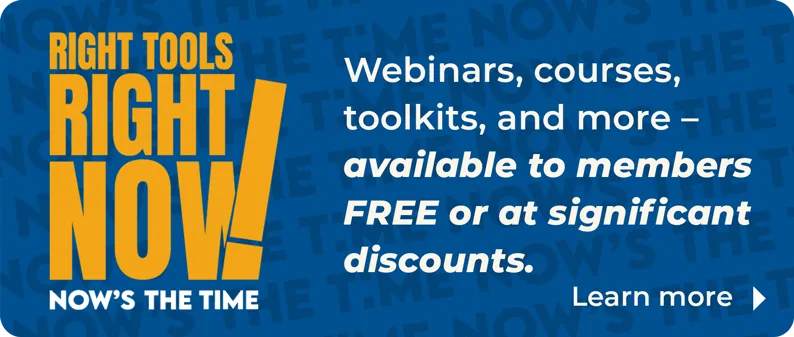If a company collected the data trail you leave online (every Web site visited, every search term entered, every credit card purchase, every text, tweet, and photo upload) and then added in all of your statistical data (age, income, kids, mortgage, education, square footage of your house and so on), might it be able to predict where you’re likely to go on vacation or what car you’re most likely to buy? Probably.
That’s the idea behind big data analytics: predicting how people or businesses will act based on patterns or models extracted from their data. The more data you have, the more accurate the predictions can be. We can see it today in the array of consumer data that makes up your credit score, which represents your likelihood to repay a loan.
Perhaps only the National Security Agency has access to your full data trail, but REALTOR® associations can make sound member and market predictions based on far less information.
NAR’s new Predictive Analytics group, headed by Todd Carpenter, hopes to someday be able to anticipate which REALTORS® are most likely to rise to leadership positions, which are most likely to buy certain products, and which are most likely respond to a political call to action or contribute to RPAC, for example.
The national association’s plan is to compile all the information it collects about members—potentially including data from state and local associations, MLSs, and other sources—in one place and make forecasts based on behavior patterns, as well as develop tools to help REALTORS®, state and local associations, and others make better data-driven decisions.
“But before we really can offer predictive products,” Carpenter says, “we have to focus on gathering all of this data and putting it in one place.”
Unique data about members is collected by every NAR department but not currently connected in a usable way, Carpenter says. “For instance, if you work in community and political affairs, you know a lot about which members vote and respond to calls for action or give money to RPAC, but you don’t know if they’re taking the ABR course or attending the conference, or which NAR newsletters they subscribe to.”
Putting all of this data together—using RAMCO, the membership management software developed by REALTOR® AEs—is the first step toward finding the members who are very engaged in the association, those who are just barely engaged, and those who are engaged in certain ways, like those interested in e-learning.
“So once we collect all that data, we can track it over time. And as we do that, we can see patterns of how someone becomes more engaged in the association,” Carpenter says. As the association identifies those patterns, it can establish which people display engagement tendencies, so that it can deliver to them the information and tools they need to lead them down the path already identified as most likely.
“So instead of blasting every member with everything we have, we can better target our efforts,” Carpenter says, saving the association time and money.
Although initially, NAR will “raid its own fridge” and compile national-level data, any picture of member activity would be incomplete without the local perspective, says Carpenter. Local data ranging from the types of education classes taken to agents’ transaction histories could prove invaluable in developing tools and services to help members boost business.
“Getting information from states and locals is going to be highly valuable to us. With it we can get an even better idea of how members are engaged at the local, state, and national level and put that all in one spot so locals will also have that intelligence on members,” he says.
Acquiring local and MLS member data would be a give-and-take model, Carpenter explains. “Locals and states would benefit from what we could give them in exchange for member data. That would be worked out individually with associations and MLSs regarding how much and what type of information they would like to share.”
Predicting Consumer and Market Behavior
Predicting member behavior for the benefit of the association is only the beginning of the national association’s big data initiative. Carpenter is investigating opportunities to collaborate with NAR’s research department on projects that potentially could forecast consumer trends, real estate market direction, and best business practices so that members can make better business decisions and better serve their customers.
Also harnessing the power of big data is RPR, the REALTORS® Property Resource, which is one of the biggest real estate data collections in the world, if not the biggest. RPR is a data giant, collecting information from a growing number of sources every day on millions of properties. “[RPR] is using predictive analytics now in its ability to predict the marketability of a home,” notes Carpenter.
Carpenter hosted a session at the AE Institute detailing where NAR is headed with big data. “Hopefully, associations can drive down the same path,” he says. “We’re still building out the department and it will be some time before we have products to deliver, but we want to keep AEs apprised of what’s going on.”
Big Data on a Small Scale
Even if you don’t have terabytes of data on your local members, you can still participate in the big data movement and lay the foundation. To position your organization to reap rewards from big data in the near future, first recognize data collection at the strategic level of your association, advises Patrick Dorsey, vice president of marketing at Avectra association management software, in his e-book “Demystifying Big Data for Associations.” The entire organization, not just the IT department, should have access to and ownership of data.
Association executives should look at the types of unique data they are already gathering and then look at what data they could be gathering.
Associations already use member surveys, Web traffic analytics, e-mail open rates, and a number of other metrics to qualify and quantify program and product successes. Combine this with member-specific data, and you’re on your way to building a big data profile of your membership.
Contrary to an annual member survey project or focus group program, data collection is not a line item in your budget, but should be built into all processes and practices at your association from now on, notes Dorsey. Every program should have a data collection element and every new technology investment should have robust data-capture capabilities.
One element of data most associations are not currently collecting from members but should, says Carpenter, is social media activity from Twitter, LinkedIn, and Facebook. “These are the places where members are talking about the issues in real estate. This is where you could track how much a member spoke online about issues, who are the ones that are the strongest advocates for a particular issue, who are the people who may oppose a particular issue. It would help us do a better job of listening if we could isolate not just who’s talking about real estate, but which REALTORS® are talking about it.”
Your association management software is a good place to start collecting and tagging your member data. Systems such as RAMCO have robust capabilities to capture and tag data such as who signed up for events and who called your hot line for information.
Although “big data” is the much-hyped buzz phrase in business today, Carpenter cautions against state or local REALTOR® associations investing too much in consultants or the latest big data tools just yet. “It’s still a new field and there’s a lot to learn. It remains to be seen who can actually deliver great analytic products at a decent price.”
The revival of NAR’s Master Member Profile System, which was abandoned in 2008 for data storage cost reasons, was announced at the AE Institute. The MMPS is a member database incorporating NRDS member data with data from other sources, including public records and data volunteered from members themselves. It is not a replacement for NRDS.








